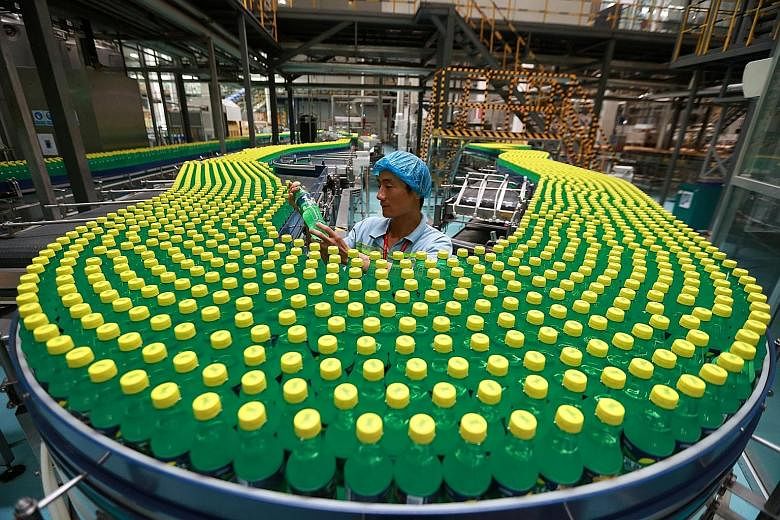SINGAPORE • Asia's factories showed few signs of returning to health last month, as torpid activity in the region's biggest economies - China and Japan - suggested world demand remained fitful at best, even as global policymakers scrambled to restore momentum.
Coming a week after the United States posted sluggish second-quarter growth, Asia's uninspiring manufacturing surveys may give US Federal Reserve chair Janet Yellen pause for thought ahead of a Fed meeting from Sept 20-21 to decide whether to raise interest rates.
Moreover, the impact of Britain's shock decision in June to quit the European Union is seen chilling consumption, leaving factories struggling to clear their goods.
-
50.4
CHINA
Its factory activity last month showed scant growth but stood just above July's 49.9.
-
49.5
JAPAN
As compared to July's 49.3, activity held steady but was still in contraction reading below 50.
-
47.4
MALAYSIA
Manufacturing activity contracted at a faster rate last month than in July which logged a rate of 48.1.
-
52.6
INDIA
Activity expanded at its fastest pace since mid-2015, but growth slipped to its lowest in Q2 this year.
-
51.7
EURO AREA
Activity at Euro area factories rose at the weakest pace in 18 months last month as demand faltered.
-
49.4
UNITED STATES
Manufacturing sector contracted last month, after five straight months of expansion.
In China, the world's second-biggest economy, factory activity showed scant growth.
The official Purchasing Managers' Index (PMI) ticked up to 50.4 last month, compared with the previous month's 49.9 and just above the 50-point mark that separates growth from contraction.
But the private Caixin version of the PMI, which covers a greater share of smaller firms, showed activity stagnated last month with the index at 50.0, from an unexpectedly upbeat 50.6 in July.
"Downward pressure on China's economy remains and government support to stabilise growth must continue," said CEBM Group macroeconomic analysis director Zhong Zhengsheng, in a note accompanying the Caixin PMI report.
Indeed, with central banks almost exhausting their monetary policy support, governments in Asia have increased fiscal stimulus, although underlying demand in many of the region's export-reliant economies remains weak.
"A still-subdued external demand environment and fading policy pass-throughs are weighing on aggregate demand in the region," said Morgan Stanley senior economist Chetan Ahya.
"In the near term, the growth trajectory will depend on the trend in external demand, and monetary and fiscal policy response."
In Japan, while manufacturing activity showed signs of steadying, the IHS Markit/Nikkei PMI was still in contraction at 49.5 last month, versus 49.3 in July.
Export orders continued to fall, even as output increased for the first time in six months, backing expectations that the Bank of Japan will need to offer more stimulus on top of its already massive easings to revive a sputtering economy. The pressure on Japanese policymakers was underscored by separate data showing Japanese business expenditure fell in the April-June period from the previous quarter.
Conditions were even more gloomy in South Korea, a bellwether for global demand.
An extended slide in exports put manufacturers in Asia's fourth-largest economy to the sword, with the August PMI contracting at its fastest pace in a year.
Other data showing South Korean exports rebounded last month was seen as an aberration due to two extra working days this year.
"Given that South Korea acts as a harbinger for the rest of Asia, we believe Asia's cycle is now headed for another down move," said Mr Vaninder Singh, Asia economist at RBS, in a note.
The situation in Malaysia was no better, with manufacturing activity last month (47.4) contracting at a quicker rate than in July (48.1), although Taiwan was a surprising outlier with activity there expanding at the fastest pace in 1-1/2 years.
Its August reading was 51.8, better than the previous month's 51.0.
Still, broad-based weakness in external demand called for further policy support, including interest rate cuts, analysts said.
"We won't rule out rate cuts in Malaysia or South Korea, and expect further monetary policy easing in Indonesia, Taiwan and Thailand this year," said Ms Krystal Tan, Asia economist at Capital Economics.
There were some encouraging signs in India where August factory activity expanded at its fastest pace in 13 months, but investors will have to square that with data released on Wednesday that showed economic growth slipped to over a one-year low between April and June.
REUTERS

